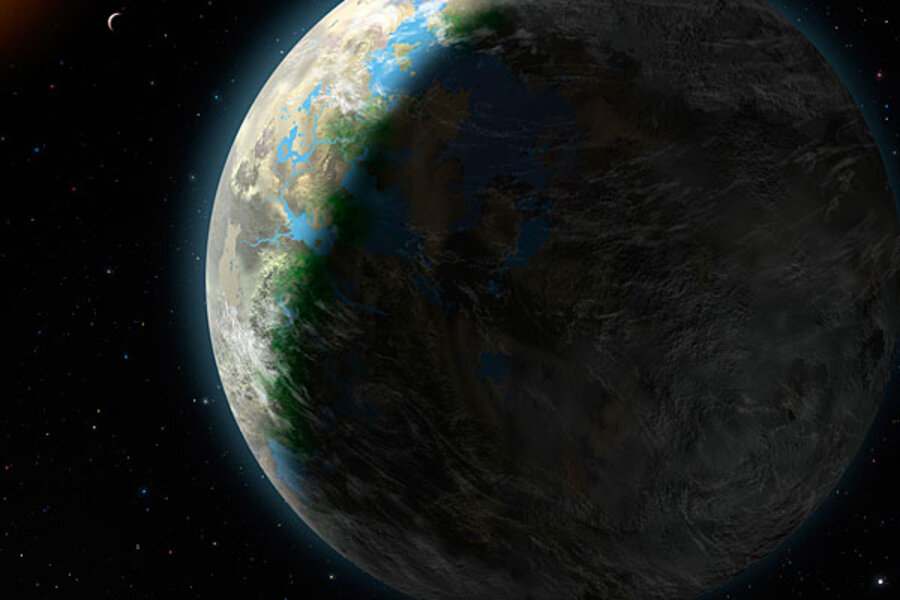Gliese 581g: If there's life there, how will we know?
Loading...
After spending decades searching for alien planets capable of harboring life, astronomers may have found one. So how can they check to see if life actually exists on this alien world?
Last week (Sept. 29), a team of researchers announced the discovery of Gliese 581g, a rocky, roughly Earth-size planet in its parent star's so-called "habitable zone" — a just-right range that can allow liquid water to exist.
One of the planet's discoverers said in a briefing yesterday that "the chances of life on this planet are 100 percent." To determine if this is true, researchers will have to scrutinize Gliese 581g from afar, searching its atmosphere for certain telltale molecules.
But it might be a while before they have the tools to do this properly.
Listening for signals
Gliese 581g isn't far from Earth in the great scheme of things — only 20.5 light-years or so. But that translates to about 120 trillion miles (194 trillion kilometers) — 500 million times farther away from us than the moon. [Tour the six Gliese 581 planets.]
So human-built probes won't be getting out there anytime soon. But one way to look for life on Gliese 581g is to turn our radio telescopes toward the planet, searching for patterns in emissions of electromagnetic radiation.
Such patterns could indicate the presence of intelligent life, according to Seth Shostak of the SETI (Search for Extraterrestrial Intelligence) Institute in Mountain View, Calif.
The Gliese 581 star system has intrigued researchers for a while, so they've already taken a few looks. During SETI's Project Phoenix, which surveyed almost 1,000 star systems from 1995 to 2005, astronomers looked at Gliese 581 twice, Shostak said.
"No signal was found during these observations," he told SPACE.com.
What's in your air?
Life doesn't have to be intelligent and advanced for astronomers to pick it up. Studying Gliese 581g's atmosphere, for example, could theoretically reveal the presence of organisms as simple as microbes.
This method assumes the alien planet has an atmosphere, likely a necessity for life to take hold. Gliese 581g's discoverers reported that the planet's gravity is probably strong enough to hold onto an atmosphere, but they didn't definitively detect one.
"The first thing is, you've got to have an atmosphere," said Bill Borucki of NASA's Ames Research Center, the science principal investigator for NASA's planet-hunting Kepler mission. "If there is one, then what's the composition of that atmosphere?"
If astronomers detect the signatures of large, complicated compounds — like chlorofluorocarbons, which people have manufactured to use as refrigerants and propellants — life is likely, according to Borucki.
"You're looking for chemicals like that," he told SPACE.com. "If they're there, somebody's making them."
But other, simpler chemicals could also be strong evidence for life, as long as their ratios are right.
"Ideally, you'd be looking for a complement of compounds that normally don't exist in chemical equilibrium," said Jon Jenkins of the SETI Institute, the analysis lead for the Kepler mission.
As an example, both Jenkins and Borucki pointed to methane and oxygen.
"You typically don't have both gases present in significant quantities unless life is present," Jenkins told SPACE.com. But scientists would have to be careful how they interpreted such information, he added, because we don't know much about how other planetary systems tick.
"Though scientists get excited about these discoveries just like the public does, we also tend to be pretty cautious," Jenkins said.
Tough job for today's tech
So scanning Gliese 581g's atmosphere, if it has one, would give us a good idea if the planet harbors life or not. But it'll probably be a few decades before we can do this properly.
Astronomers have characterized the atmospheres of alien planets before. But those other worlds are bigger and much hotter, meaning they throw off lots of radiation for our instruments to pick up. Gliese 581g is relatively close to Earth, but its other traits make it a tough read.
It's only about three to four times as massive as Earth, for example, with an average surface temperature between minus 24 and minus 10 degrees Fahrenheit (minus 31 to minus 12 degrees Celsius).
"Because they are cool and small, planets like this are very difficult to study," Jenkins said. "It's easier to detect something than to characterize it in detail."
Jenkins said that Gliese 581g also apparently doesn't transit its parent star, meaning it doesn't cross in front of it from our perspective on Earth. Astronomers can learn a lot about a planet's atmosphere by studying starlight that passes through it — but this technique is likely not an option with Gliese 581g.
As a result, the tools astronomers currently have at their disposal likely can't determine what's in Gliese 581g's air, according to Borucki and Jenkins. So researchers will have to wait for new instruments to come into play.
A few decades away
One promising tool mentioned by Borucki, Jenkins and Shostak is NASA's proposed Terrestrial Planet Finder (TPF) mission, which would use an array of telescopes orbiting Earth to generate detailed images of alien planets.
TPF would employ advanced techniques to reduce the glare of the exoplanets' parent stars, allowing the mission to pick up faint radiation coming from planets. The mission could theoretically detect chemicals like methane and oxygen in the atmospheres of alien worlds such as Gliese 581g.
The TPF mission, however, is in limbo. It is currently unfunded, with no launch date set. So researchers will probably have to wait a while before they can see what Gliese 581g's atmosphere is made of.
Whenever TPF, or something like it, comes along, it may have a long list of planets to check out, Jenkins said.
"I would predict that [Gliese 581g] is just the tip of the iceberg," he said. "Fifteen or 20 years ago, very few people thought we'd be discovering such extrasolar planets anytime soon. This find just shows how far we've come."





